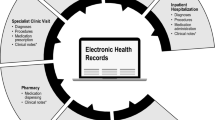Abstract
Routine healthcare data is becoming widely available, usually as a result of administrative systems. Other related data are also often available, such as biochemistry results, mortality data, and sometimes prescribing data. These records are often linked via a common identification system or by probability matching techniques. These data sources offer many opportunities to undertake research, and where prescription data are recorded and linked, the facility to research the outcome of drug use often exists. There are now a number of research agencies around the world that use these large routine data sources to undertake drug safety and outcome studies. The purpose of this commentary is to describe some of the history behind the development of these systems, illustrate some of their uses with respect to postmarketing drug safety and to other healthcare research objectives. The review then describes the data sources necessary to develop a system that would offer an optimal system to undertake a range of studies, including population drug safety surveillance. There are both positive and negative considerations when using routine data. On the positive side, these data come from ‘real life’ experiences and not from the clinical trial situation. On the other hand, there are important biases to be aware of such as confounding by indication. On the whole, it is argued that large databases originating from routine healthcare procedures have an important role to play in the cost-effective prescription drug use in the postmarketing setting. These systems cannot replace other methods of drug safety evaluation but they do offer an important adjunct to spontaneous reporting systems.
Similar content being viewed by others
References
Jick H, Jick SS, Derby LE. Validation of information recorded on general practitioner based computerised data resource in the United Kingdom. BMJ 1991; 302: 776–8
Goves JR, Davies T, Reilly T. Computerisation of primary care in Wales. BMJ 1991; 303: 93–4
Chisholm J. The Read classification system. BMJ 1990; 300: 1092
Information Management Group. NHS Centre for coding classification: general information. Leicester: NHS Management Executive, 1992
Körner E (Chairman). Report on the collection and use of information about hospital clinical practice activity in the National Health Service. London: Her Majesty’s Stationery Office, 1982
Williams DRR. Hospital admissions for diabetic patients: information from hospital activity analysis. Diabet Med 1984; 2: 27–32
Henderson J, Goldacre MJ, Graveney MJ, et al. Use of medical record linkage to study readmission rates. BMJ 1989; 299: 709–13
Currie CJ, Morgan CL, Gill L, et al. The epidemiology and costs of acute hospital care for cerebrovascular disease in diabetic and non-diabetic populations. Stroke 1997; 28: 1142–6
Sackett DL. Bias in analytic research. J Chronic Dis 1979; 32: 51–63
Poses RM, Smith WR, McClish DK, et al. Controlling for confounding by indication for treatment. Are administrative data equivalent to clinical data? Med Care 1995; 33: AS36–46
Shapiro S. The role ofautomated record linkage in the postmarketing surveillance of drug safety: a critique. Clin Pharmacol Ther 1989; 46: 371–86
Waller PC, Wood SM, Langman MJS, et al. Review of company postmarketing surveillance studies. BMJ 1992; 304: 1470–2
Mitchell P. Shock as troglitazone withdrawn in the UK. Lancet 1997; 350: 1685
Ray WA, Griffin MR. Use of Medicaid data for pharmacoepidemiology. Am J Epidemiol 1989; 129: 837–49
Strom BL, Carson JL. Use of automated databases for pharmacoepidemiology research. Epidemiol Rev 1990; 12: 87–107
Jick H. The Boston Collaborative Drug Surveillance Program and the Puget Sound Health Maintenance Organization. Drug Info J 1985; 19: 237–42
Malcolm E, Downey W, Strand LM, et al. Saskatchewan Health’s linkable data bases and pharmacoepidemiology. Post Mark Surveill 1993; 6: 175–264
Jick H, Jick SS, Derby LE. Validation of information recorded on general practitioner based computerised data resource in the United Kingdom. BMJ 1991; 302: 766–8
Jick H, Terris BZ, Derby LE, et al. Further validation of information recorded on a general practitioner based computerized data resource in the United Kingdom. Pharmacoepidemiol Drug Saf 1992; 1: 347–9
Evans JMM, McDevitt DG, MacDonald TM. The Tayside Medicines Monitoring Unit (MEMO): a record-linkage system for pharmacovigilance. Pharmaceut Med 1995; 9: 177–84
Gill GV, Lucas S, Kent LA. Prevalence and characteristics of brittle diabetes in Britain. Q J Med 1996; 89: 839–43
Morris AD, Boyle DI, McMahon AD, et al. Adherence to insulin therapy, glycaemic control and ketoacidosis in insulin-dependent diabetes. Lancet 1997; 250: 1505–10
McMahon AD, Evans JM, White G, et al. A cohort study (with re-sampled comparator groups) to measure the association between new NSAID prescribing and upper gastrointestinal haemorrhage and perforation. J Clin Epidemiol 1997; 50: 351–6
Morris AD, Boyle DIR, MacAlpine R, et al. The diabetes audit and research in Tayside Scotland (DARTS) study: electronic record linkage to create a district diabetes register. BMJ 1997; 325: 524–8
Gill L, Goldacre M, Simmons H, et al. Computerised linkage of medical records: methodological guidelines. J Epidemiol Community Health 1993; 47: 316–9
Acknowledgements
Craig Currie works for GlaxoWellcome R&D. However, the objectives of this review involve no conflict of interest.
Author information
Authors and Affiliations
Corresponding author
Rights and permissions
About this article
Cite this article
Currie, C.J., MacDonald, T.M. Use of Routine Healthcare Data in Safe and Cost-Effective Drug Use. Drug-Safety 22, 97–102 (2000). https://doi.org/10.2165/00002018-200022020-00002
Published:
Issue Date:
DOI: https://doi.org/10.2165/00002018-200022020-00002



